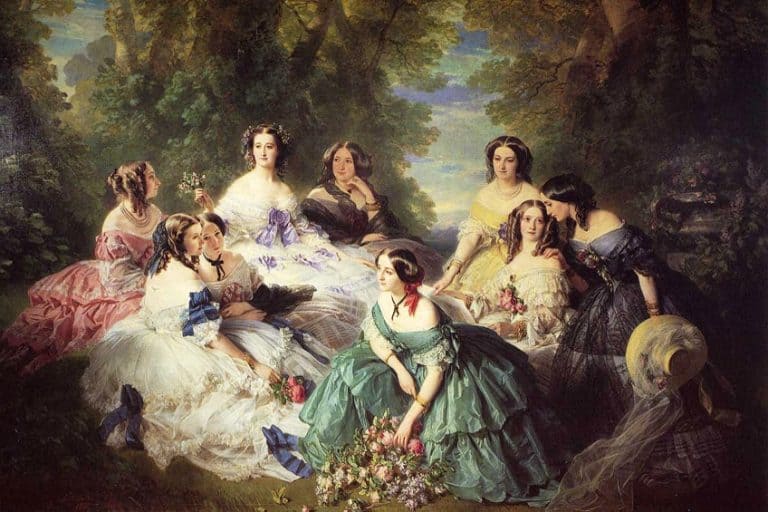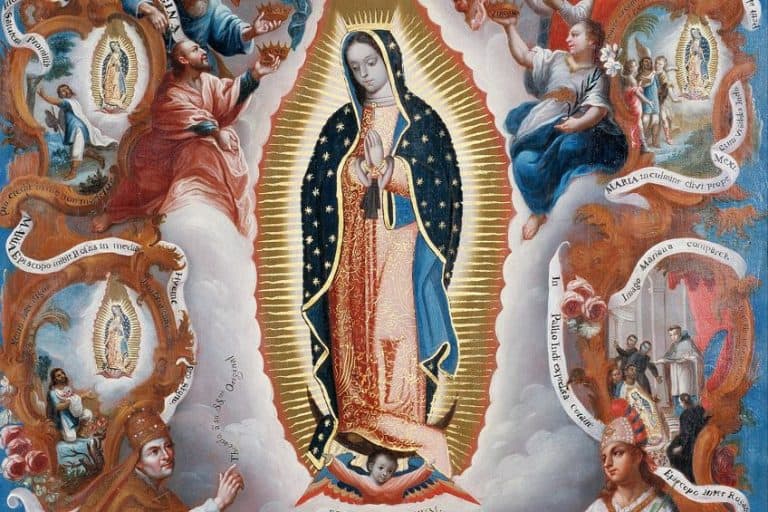Contrast in Art – What Is Contrast in Art?
Contrast in artwork creates interest and diversity and without it, a painting, sculpture, drawing, or any form of art would be bland and boring. In this article, we will discuss the contrast in art definition and mention several examples of how it is utilized.
The Principles of Art
Contrast is one of the art principles, but before we discuss the question, “what is contrast in art?”, we will provide a brief overview of the principles of art, which will provide a deeper understanding within a broader context of the composition of visual art.
There are several principles of art, namely emphasis, movement, rhythm, balance, harmony, variety, unity, proportion, scale, pattern, and repetition. These principles are also referred to as the principles of design.
| Art Principle | Characteristics |
| Emphasis | This is utilized to draw a viewer’s attention to the main subject matter or focal point. |
| Movement | This creates different effects that lead the viewer’s gaze around the composition making it more interesting and engaging. |
| Rhythm | This is related to movement and pattern, which can be arranged in a variety of ways to create desired visual effects. |
| Balance | This refers to how well all the art elements are applied in a visual composition and referred to as the “distribution of visual weight” in an artwork. |
| Harmony | This is when art elements are applied similarly and correlate with the overall composition to create a visual harmony. |
| Variety | This creates a difference and gives a fresh change to visual compositions through different art elements. |
| Unity | This is related to all the parts of a visual composition working together in unison. |
| Proportion | This depicts the size differences between parts of a subject in a visual composition. |
| Scale | This depicts the size differences between two different types of subject matter. |
| Pattern | This relates to sequences or arrangements of different motifs that can be for decoration or to create movement, or other effects. |
| Repetition | This is closely related to patterns and consists of duplicating motifs in a visual composition to add emphasis, create movement, or character. |
Organizing the Elements of Art
The principles of a rt are like organizing artistic tools that give more meaning to the elements of art, and ultimately the visual composition, but what are the elements of art? There are seven widely known art elements, namely color, value, shape, form, line, space, and texture.
To illustrate how an art element would be organized by an art principle, think of a painting where most of the colors are greens and blues and painted in thick horizontal bands filling up the canvas.
The art principles of harmony and balance would inform this painting because the colors are the same color temperature and therefore creates a compositional “color harmony”, so to say, as well as the thick texture of the horizontal bands of paint.
Now, think of the same painting where splashes of bright neon yellow and orange are added, the art principles of variety and contrast would organize this composition as the colors would notably clash, be different temperatures, and the splashes of paint would create a contrasting texture, ultimately adding more character to the painting. This is just one of many examples of how the art principles work together with the art elements to create all sorts of visual compositions, from realistic to abstract depictions.
When you look at a painting or sculpture, you will be able to see the interplay of both. Can you think of your own example?
| Art Element | Characteristics |
| Color | This includes the range of the color wheel and the different color schemes, as well as the brightness, lightness, and darkness of how colors are applied in a visual composition. |
| Value | This relates closely to color, but is mostly concerned with conveying the darkness and lightness of a hue, not to be confused with the brightness of it. |
| Shape | There are geometric and organic types of shapes and these are identified more on a two-dimensional scale. |
| Form | Similar to shapes, there are also geometric and organic types of forms, but they occur on three-dimensional scales. |
| Line | These create the foundational shapes of subject matter and can also be added to create movement, rhythm, or emphasis on a focal point. |
| Space | This refers to the compositional area in and around an artwork, and also differentiates the “positive” and “negative” areas. |
| Texture | This is related to the way brushstrokes are applied, the “tactile” qualities, but also the “implied” qualities of how a two-dimensional object will look and feel. |
What Is Contrast in Art?
Now that you have a better idea of what the principles and elements of art are, let us take a closer look at the question exploring the contrast art definition. So, what is contrast in art? Think different, non-identical, mismatched, unlike, opposed, unique, and original, all these terms describe what contrast is.
Contrast adds character, has the potential to evoke a variety of feelings and ideas, and draws attention to the main focal point in a painting, sculpture, graphic art design, and even an item of clothing!
However, do not let contrast put you off a visual composition or think that it could be too disruptive or unattractive to the point that you should not utilize it, quite the opposite. Contrast can work together with its counterparts like unity, which is one of the other art principles.
For example, unity can be achieved by applying contrasting art elements in a composition. If the same elements are utilized the composition can appear too monotonous. However, deliberately not creating too much contrast in an artwork can also make a statement and add effect. The contrast will be more evident when art elements are distinctly juxtaposed, and less apparent if there are minimal variations.
Importantly, remember that contrast is associated and often described as maintaining a level of “interest” in any artwork.
The Difference Between Contrast and Variety
Contrast is also like the other art principle called variety, and some sources suggest that variety is created by contrast, but it is important to note that both are often listed as principles of art. Variety is also about adding more character and more unique and distinct qualities to artworks. We can also look at how contrast and variety play off each other; contrast can create variety, and variety in a visual composition can create contrast, it all depends on what you want to convey.
These are just some important points to be aware of when working with contrast in art and working towards a cohesive contrast art definition.
The Types of Contrast in Art
There are various types of contrast in art, and it can be utilized for any of the art elements, from colors to shapes to space. Below we will look at a few of the common types in more depth and explain how they are applied, and the effects created accompanied by contrast painting examples.
Contrast Through Detail
Contrast through detail refers to the focus on detail in an artwork, how much is utilized, and how attention is drawn to it, which also relates to the main focal point in the composition. Some art sources suggest the importance of incorporating more detail for the focal point and less detail in areas where it is not necessarily needed.
This focus on detail and its placement in the visual composition will create contrast and lead the viewer’s gaze to where the artist intends it to be. This can be created with various art elements like color, line, or space.
This can appear differently, for example, one part of a composition can be depicted more in focus than another part, or the subject matter can take up one part of the space and the rest of the space is left empty. While there are thousands of contrast paintings, one example of how detail is utilized as contrast in artwork includes Café Terrace at Night (1888) by post-Impressionist Vincent van Gogh.
Here, the artist utilized color to convey dark and light areas of the scene; the left side is filled with yellow light and the right side, more towards the background, is darker and in shadows. Automatically, our gaze is directed towards the left-hand side of the composition where there is more to see in terms of details, which is compared to the unlit area of the street to the right with lesser details.
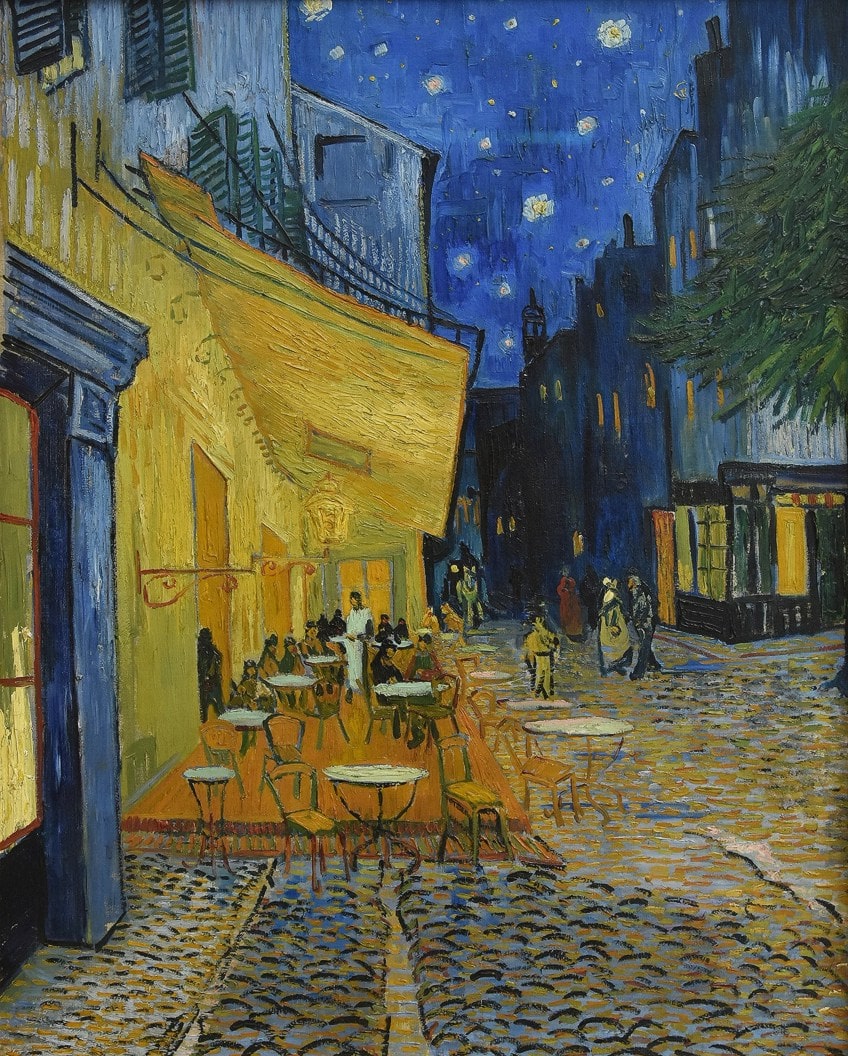
Contrast and Edges
There are different types of edges in art, all of which create different compositional effects, depending on if they are soft, hard, or lost. Edges are described as the “transition between” different shapes or forms in a visual composition. These transitions create the “border” or “line”, therefore known as the edges.
Hard edges are distinctive and create a focus on the subject matter, and soft edges are blurrier and often described as creating a “hazy” effect. Lost edges are created through the transition between shapes where the edge is barely visible.
Contrast can be created by applying different edges, which will also place the focus on the subject matter that needs the focus. An example of how edges create contrast can be seen in Le Grand Canal, Venice (1908) by the Impressionist Claude Monet. There are several iterations by Monet, and this version is housed in the Fine Arts Museum of San Francisco.

In this composition Monet created a focus on the poles to the left, which have more distinct edges compared to the Santa Maria della Salute church to the right, which has softer edges and is hazier, almost blending into the background.
Le Bonheur de Vivre (The Joy of Life) (c. 1905-1906) by Henri Matisse is another example of contrast in the artwork. The Fauvist painter created distinct outlines and hard edges around the subject matter in this composition, notably the figures filling up the foreground and most of the surrounding natural environment.
Furthermore, these outlines have been described and likened to an “arabesque line”, which also creates a movement and rhythm in the composition. Overall, the lines bolden the subject matter and make it stand out.
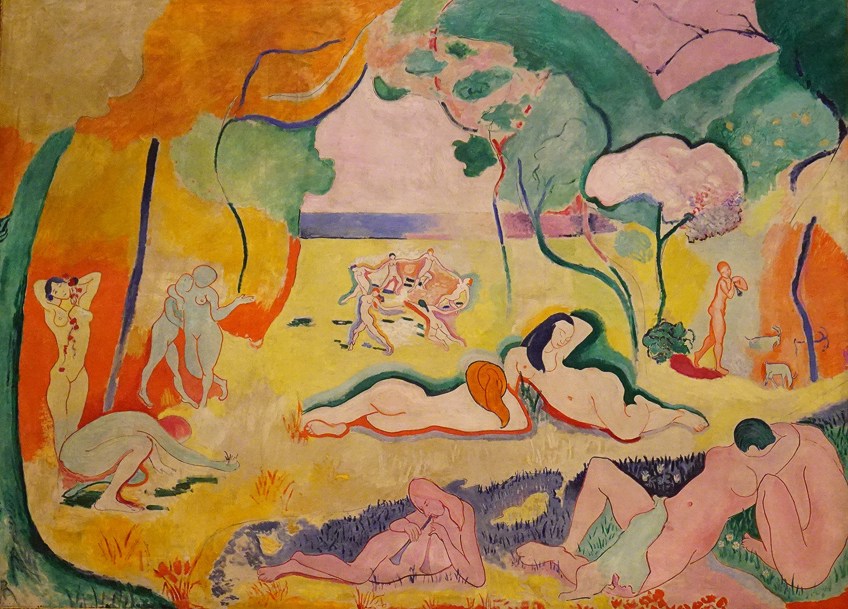
Contrast in Color
Color consists of various aspects, for example, value, saturation, and how colors occur on the color wheel, namely primary, secondary, and tertiary colors. The various positions of colors like complementary colors (colors that are opposite each other on the color wheel) will also create a contrasting effect, for example, the primary color yellow and the secondary color purple.
The levels of color value and saturation can also create focal points. Color value refers to the lightness and darkness of colors, and saturation refers to how bright color appears according to how much it has been mixed with other colors.
Examples of contrast paintings utilizing colors include those of the Post-Impressionist Vincent van Gogh; he was famous for his different color combinations, for example, in The Night Café (1888), he applied the primary color red alongside the secondary color green.
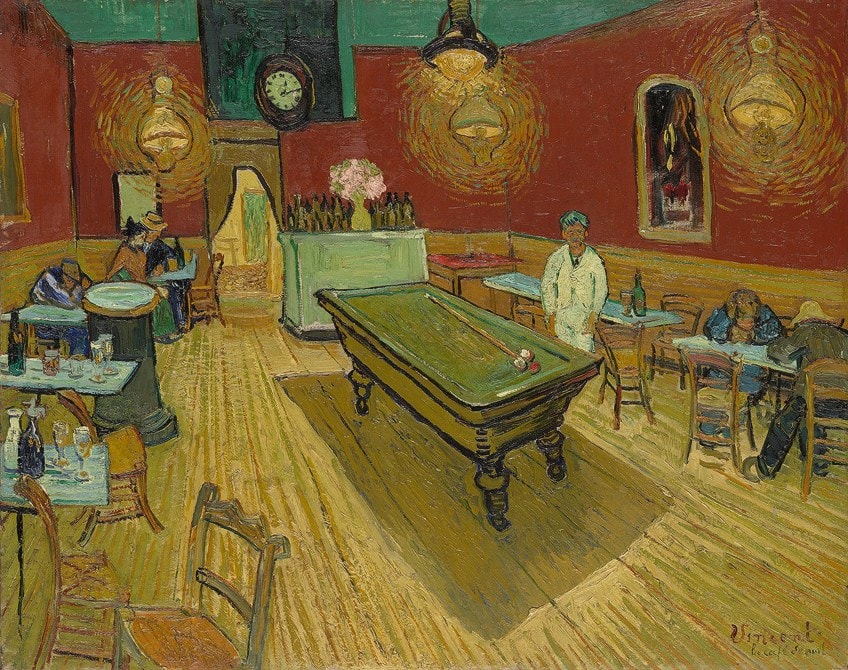
These colors create a stark setting for the interior of the café, but also echo Van Gogh’s intention to convey what he described in a letter, dated September 8, 1888, to his brother, Theo van Gogh: “the terrible human passions”.
Another example of contrast in paintings, where a color value is utilized to create depth and emphasis on the main subject matter includes The Night Watch (1642) by the well-loved Dutch Golden Age painter Rembrandt van Rijn.
Here, Rembrandt utilized dark and light areas throughout the composition that leads us, the viewers, to gaze at the two male figures in the center foreground and the female figure to the left and more into the background.

Contrast in Texture
Texture in art can be implied (the illusion of it) or real. There are also a variety of types, from smooth to coarse/rough to thick or thin. Utilizing different types of textures alongside each other in any form of art will create a contrasting effect, which will either be for emphasis, drawing attention to a focal point, or any other stylistic effect like creating depth. Examples of how texture creates contrast include many famous Dutch still life paintings, such as Still Life with Cheeses, Almonds and Pretzels (c. 1615) by Clara Peeters, who was a Flemish painter.
Here, we see the rougher textures from the food, which all appear with photographic realism, contrasted with the smoother and shinier textures from the glass and the jug.

Texture in sculpture also creates contrast, especially when the media contrasts with the environment around it. Jeff Koons’ famous Balloon Dog (Magenta) (1994-2000), which is made from stainless steel, is larger-than-life and rendered in a brilliant metallic magenta.
It was on display in one of the rooms in the Palace of Versailles in France, which was an ideal environment to create focus and interest in the sculpture as the stark stainless steel contrasted with the centuries-old furniture and decorations, bridging the old and new.
Contrast in Shape
There are two types of shapes in visual arts, namely geometric like squares, circles, rectangles, and triangles, and organic shapes that mimic that of nature and would appear curvier and more fluid. You can create contrast by placing both types of shapes alongside one another in visual composition, whether it is a painting or a sculpture. An example of how shapes create contrast in art can be found in M. C. Escher’s Sky and Water I (1938).
In this woodcut print, there are organic shapes that follow the form of animals, birds, and fish.
However, their patterned arrangement creates a more geometric contrast, which includes the overall diamond shape of their composition with the white and black rectangles composing the background. Another example includes the painting Harlequin’s Carnival (1925) by Joan Miró, which depicts an interior with a small window in the right-hand side corner. From one corner to the other, the whole composition is filled with contrasting geometric and organic shapes, including outside the window.
Contrast in Size
Depicting subject matter in different sizes in a visual composition can create notable contrasting effects. The art principles of scale and proportion can be utilized to indicate varying sizes. For example, some images may appear larger than life, and others miniature to add emphasis and hint at deeper meanings.
Some examples of how size can make a difference include the stainless steel and aluminum sculpture Spoonbridge and Cherry (1988) by Claes Oldenburg and Coosje van Bruggen. Here, we see a larger-than-life spoon with a cherry almost on the top tip of the spoon.
The spoon also lies over a pond – a notable contrast in artwork that physically engages the viewers.

The largeness of the spoon and cherry, objects we see in our everyday lives, are placed in a natural environment (the Minneapolis Sculpture Garden in Minnesota, the United States of America), which automatically creates a contrast and makes a statement. If these objects were regular size, the effect would be different.
Another example of how size creates contrast can be seen in Surrealist Salvador Dalí’s oil on canvas, The Elephants (1948). There are two large elephants on either side of this composition, their legs are long, and they reach the red sky above. However, there are also two small figures and what appears to be part of a building structure below, between the elephants.
The landscape appears otherworldly and the immense difference in sizes creates a contrast that adds to the surreal.
Appreciation Through Differences
Contrast is an important art principle that works alongside the art elements mentioned above. It creates diversity and highlights the main focal points, and without it, a work of art will lack character and possibly visual direction. It allows us, the viewers, to appreciate it through a variety of differences.
In this article, we have outlined just a few of the common types of contrast in art as well as several contrast painting examples. However, it is encouraged that you read and research further about the contrast art definition because there are multitudes of methods available to create contrast in art – it is a vast art universe.
Frequently Asked Questions
What Is Contrast in Art?
Contrast in art is one of the principles of art. It is applied when art elements are placed in different or opposite positions in a visual composition. This creates varying effects like depth or emphasis and leads the gaze to the primary focal point or subject matter.
What Are the Principles of Art?
There are several main principles of art that can apply to all types of art like paintings, graphic design, sculpture, or drawing. These include contrast, variety, harmony, unity, scale, proportion, movement, rhythm, balance, repetition, and pattern. These organize how art elements are arranged in an artwork.
What Are the Elements of Art?
There are seven common elements of art, namely color, value, space, texture, line, form, and shape. These elements of art are utilized to create a visual composition and can be arranged in almost endless ways, depicting more realistic/naturalistic compositions to abstract and geometric.
Isabella studied at the University of Cape Town in South Africa and graduated with a Bachelor of Arts majoring in English Literature & Language and Psychology. Throughout her undergraduate years, she took Art History as an additional subject and absolutely loved it. Building on from her art history knowledge that began in high school, art has always been a particular area of fascination for her. From learning about artworks previously unknown to her, or sharpening her existing understanding of specific works, the ability to continue learning within this interesting sphere excites her greatly.
Her focal points of interest in art history encompass profiling specific artists and art movements, as it is these areas where she is able to really dig deep into the rich narrative of the art world. Additionally, she particularly enjoys exploring the different artistic styles of the 20th century, as well as the important impact that female artists have had on the development of art history.
Learn more about Isabella Meyer and the Art in Context Team.
Cite this Article
Isabella, Meyer, “Contrast in Art – What Is Contrast in Art?.” Art in Context. October 4, 2022. URL: https://artincontext.org/contrast-in-art/
Meyer, I. (2022, 4 October). Contrast in Art – What Is Contrast in Art?. Art in Context. https://artincontext.org/contrast-in-art/
Meyer, Isabella. “Contrast in Art – What Is Contrast in Art?.” Art in Context, October 4, 2022. https://artincontext.org/contrast-in-art/.




